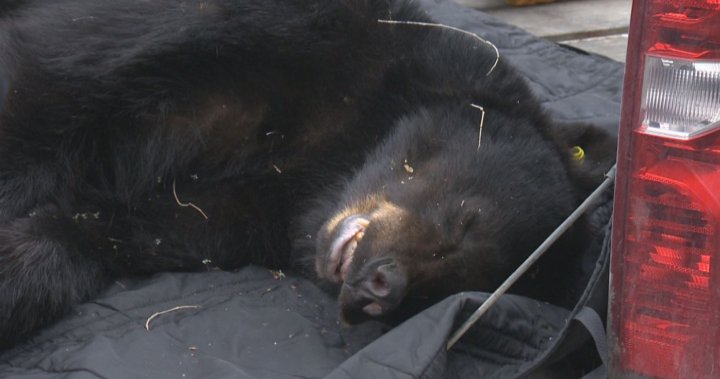A young black bear in Kelowna, estimated to be four to five years old and weighing 250 pounds, was tranquillized by conservation officers near downtown Kelowna. The bear, which will be ear-tagged, was spotted in a tree not far from the former McDonald’s restaurant near the W.R. Bennett Bridge. This bear had been sighted in the hospital area multiple times in the past seven to 10 days, prompting action from conservation officers to ensure its safety and the safety of the public. Ken Owens of the Conservation Officer Service described the situation as “an extremely rare” survival incident, emphasizing the importance of taking measures to protect the bear.
The province has provided a line and website, Report All Poachers and Polluters, that the public can contact for wildlife sightings in urban areas. Additionally, WildSafe BC offers information on bear sightings and provides guidance on how to handle encounters with wildlife. Owens encouraged the public to report bear sightings to ensure conservation officers are aware of the situation and can take preventive measures. He stressed the need for people to change their behavior, especially when it comes to leaving garbage bins out on city streets overnight, which can attract bears looking for food rewards.
Owens emphasized the importance of bear prevention efforts in Kelowna, as the city is surrounded by green areas where wildlife often reside. He warned that if the bear returns to the downtown area, it may have to be euthanized to protect public safety. Owens expressed regret over having to euthanize animals but stated that it is sometimes necessary. He called on the local community to take responsibility for their actions and ensure that garbage is properly stored to prevent attracting bears. Owens also recommended the use of bear-resistant garbage cans in communities to further protect wildlife and property from potential conflicts.
Conservation officers face the challenge of dealing with wildlife conflicts more frequently than people realize, highlighting the need for collective action to protect both animals and residents. Owens pointed out that by working together to change behaviors and take preventive measures, everyone can benefit. He stressed that efforts to protect wildlife and ensure public safety are a shared responsibility that requires cooperation from all community members. By implementing measures such as using bear-resistant garbage cans and practicing proper waste management, individuals can contribute to creating a safer environment for both humans and wildlife. Owens encouraged residents to take proactive steps to prevent bear encounters and reduce the likelihood of situations that may ultimately result in euthanizing animals.
In conclusion, the tranquilization and relocation of the young bear in Kelowna serve as a reminder of the importance of wildlife conservation and responsible stewardship of natural resources. Conservation officers play a crucial role in managing conflicts between humans and wildlife, seeking to protect both animals and the public. By reporting wildlife sightings and taking preventive measures, individuals can contribute to creating a harmonious coexistence with local wildlife. The incident with the bear in Kelowna underscores the need for ongoing efforts to educate the public and promote sustainable practices that minimize the risk of wildlife encounters. Ultimately, by working together to change behaviors and promote responsible environmental practices, communities can help preserve the natural beauty and biodiversity of their surroundings.


